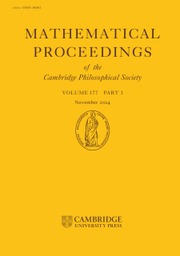Crossref Citations
This article has been cited by the following publications. This list is generated based on data provided by Crossref.
Englman, Robert
1958.
On the escape of impurities from solids.
Philosophical Magazine,
Vol. 3,
Issue. 34,
p.
1081.
Iosifescu, M.
and
Tăutu, P.
1973.
Stochastic processes and applications in biology and medicine I.
Vol. 3,
Issue. ,
p.
11.
Berretti, Alberto
and
Sokal, Alan D.
1985.
New Monte Carlo method for the self-avoiding walk.
Journal of Statistical Physics,
Vol. 40,
Issue. 3-4,
p.
483.
Sokal, Alan D.
and
Thomas, Lawrence E.
1989.
Exponential convergence to equilibrium for a class of random-walk models.
Journal of Statistical Physics,
Vol. 54,
Issue. 3-4,
p.
797.
Baker, Christopher M.
Hughes, Barry D.
and
Landman, Kerry A.
2013.
Random walks in nonuniform environments with local dynamic interactions.
Physical Review E,
Vol. 88,
Issue. 4,



